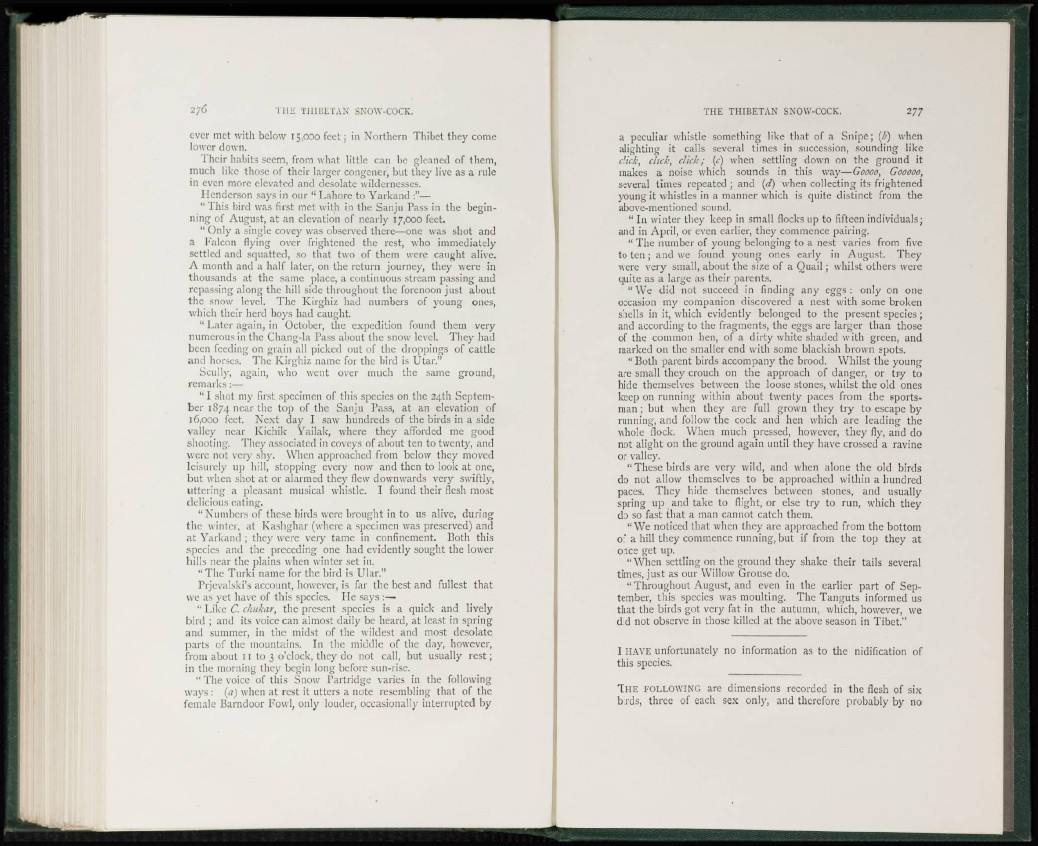
2 / 6 THE THIBETAN SNOW-COCK.
ever met with below 15,000 feet; in Northern Thibet they come
lower down.
Their habits seem, from what little can be gleaned of them,
much like those of their larger congener, but they live as a rule
in even more elevated and desolate wildernesses.
Henderson says in our "Lahore to Yarkand :"—
" This bird was first met with in the Sanju Pass in the beginning
of August, at an elevation of nearly 17,000 feet.
" Only a single covey was observed there—one was shot and
a Falcon flying over frightened the rest, who immediately
settled and squatted, so that two of them were caught alive.
A month and a half later, on the return journey, they were in
thousands at the same place, a continuous stream passing and
repassing along the hill side throughout the forenoon just about
the snow level. The Kirghiz bad numbers of young ones,
which their herd boys had caught.
" Later again, in October, the expedition found them very
numerous in the Chang-la Pass about the snow level. They bad
been feeding on grain all picked out of the droppings of cattle
and horses. The Kirghiz name for the bird is Utar."
Scully, again, who went over much the same ground,
remarks :—
" I shot my first specimen of this species on the 24th September
1874 near the top of the Sanju Pass, at an elevation of
16,000 feet. Next day I saw hundreds of the birds in a side
valley near Kichik Yailak, where they afforded me good
shooting. They associated in coveys of about ten to twenty, and
were not very shy. When approached from below they moved
leisurely up hill, stopping every now and then to look at one,
but when shot at or alarmed they flew downwards very swiftly,
uttering a pleasant musical whistle. I found their flesh most
delicious eating.
" Numbers of these birds were brought in to us alive, during
the winter, at Kashghar (where a specimen was preserved) and
at Yarkand ; they were very tame in confinement. Both this
species and the preceding one had evidently sought the lower
hills near the plains when winter set in.
"The Turki name for the bird is Ular."
Prjevalski's account, however, is far the best and fullest that
wTe as yet have of this species. He says :—•
" Like C. chukar, the present species is a quick and lively
bird ; and its voice can almost daily be heard, at least in spring
and summer, in the midst of the wildest and most desolate
parts of the mountains. In the middle of the day, however,
from about 11 to 3 o'clock, they do not call, but usually rest;
in the morning they begin long before sun-rise.
" The voice of this Snow Partridge varies in the following
ways : (a) when at rest it utters a note resembling that of the
female Barndoor Fowl, only louder, occasionally interrupted by
THE THIBETAN SNOW-COCK, 277
a peculiar whistle something like that of a Snipe; (/>) when
alighting it calls several times in succession, sounding like
click, click, click; (c) when settling down on the ground it
makes a noise which sounds in this way—Goooo, Gooooo,
several times repeated ; and (d) when collecting its frightened
young it whistles in a manner which is quite distinct from the
above-mentioned sound.
" In winter they keep in small flocks up to fifteen individuals;
and in April, or even earlier, they commence pairing.
" The number of young belonging to a nest varies from five
to ten ; and we found young ones early in August. They
were very small, about the size of a Quail ; whilst others were
quite as a large as their parents.
"We did not succeed in finding any eggs: only on one
occasion my companion discovered a nest with some broken
shells in it, which evidently belonged to the present species ;
and according to the fragments, the eggs are larger than those
of the common hen, of a dirty white shaded with green, and
marked on the smaller end with some blackish brown spots.
"Both parent birds accompany the brood. Whilst the young
are small they crouch on the approach of danger, or try to
hide themselves between the loose stones, whilst the old ones
keep on running within about twenty paces from the sportsman
; but when they are full grown they try to escape by
running, and follow the cock and hen which are leading the
wdiole flock. When much pressed, however, they fly, and do
not alight on the ground again until they have crossed a ravine
or valley.
"These birds are very wild, and when alone the old birds
do not allow themselves to be approached within a hundred
paces. They hide themselves between stones, and usually
spring up and take to flight, or else try to run, which they
do so fast that a man cannot catch them.
" We noticed that when they are approached from the bottom
of a hill they commence running, but if from the top they at
once get up.
"When settling on the ground they shake their tails several
times, just as our Willow Grouse do.
" Throughout August, and even in the earlier part of September,
this species was moulting. The Tanguts informed us
that the birds got very fat in the autumn, which, however, we
did not observe in those killed at the above season in Tibet."
I HAVE unfortunately no information as to the nidification of
this species.
T H E FOLLOWING are dimensions recorded in the flesh of six
birds, three of each sex only, and therefore probably by no